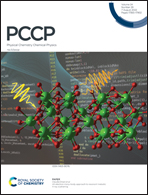Photochemically triggered cheletropic formation of cyclopropenone (c-C3H2O) from carbon monoxide and electronically excited acetylene†
Abstract
For more than half a century, pericyclic reactions have played an important role in advancing our fundamental understanding of cycloadditions, sigmatropic shifts, group transfer reactions, and electrocyclization reactions. However, the fundamental mechanisms of photochemically activated cheletropic reactions have remained contentious. Here we report on the simplest cheletropic reaction: the [2+1] addition of ground state 18O-carbon monoxide (C18O, X1Σ+) to D2-acetylene (C2D2) photochemically excited to the first excited triplet (T1), second excited triplet (T2), and first excited singlet state (S1) at 5 K, leading to the formation of D2-18O-cyclopropenone (c-C3D218O). Supported by quantum-chemical calculations, our investigation provides persuasive testimony on stepwise cheletropic reaction pathways to cyclopropenone via excited state dynamics involving the T2 (non-adiabatic) and S1 state (adiabatic) of acetylene at 5 K, while the T1 state energetically favors an intermediate structure that directly dissociates after relaxing to the ground state. The agreement between experiments in low temperature ices and the excited state calculations signifies how photolysis experiments coupled with theoretical calculations can untangle polyatomic reactions with relevance to fundamental physical organic chemistry at the molecular level, thus affording a versatile strategy to unravel exotic non-equilibrium chemistries in cyclic, aromatic organics. Distinct from traditional radical–radical pathways leading to organic molecules on ice-coated interstellar nanoparticles (interstellar grains) in cold molecular clouds and star-forming regions, the photolytic formation of cyclopropenone as presented changes the perception of how we explain the formation of complex organics in the interstellar medium eventually leading to the molecular precursors of biorelevant molecules.

- This article is part of the themed collection: 2022 PCCP HOT Articles


 Please wait while we load your content...
Please wait while we load your content...
